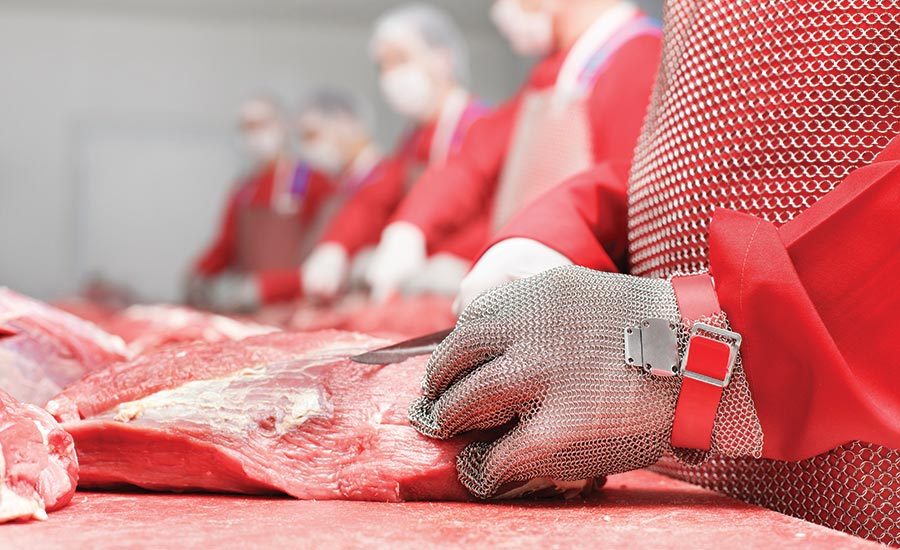How an Effective Ergonomics Program Contributes to Worker Safety

Workers in refrigerated environments dress in personal protective equipment that helps keep their bodies at a comfortable and safe temperature.
Photo courtesy of Getty Images

Hooks, pulleys and conveyors are used to transport animal parts down the processing line. Workers are trained to change their positions and take mandatory breaks to reduce injury risk.
Photo courtesy of Getty Images

In the event that an employee comes into contact with a hazardous chemical, eyewash stations like the one pictured should be readily available for immediate response.
Photo courtesy of Getty Images



According to the “2018 Liberty Mutual Workplace Safety Index”—which helps employers, risk managers and safety practitioners identify critical risk areas so that businesses can better allocate safety resources—serious workplace injuries cost U.S. businesses more than $58 billion per year.
In the food industry, meat plants are rife with serious safety and health hazards for workers. According to the Occupational Safety and Health Administration, these hazards include exposure to high noise levels, dangerous equipment, slippery floors, musculoskeletal disorders (MSDs) and hazardous chemicals (including ammonia used as a refrigerant). The Bureau of Labor Statistics reports injury and illness rates for the meatpacking industry as 2.5 times higher than the national average.
More serious injuries that require work restrictions or days away from work are more than three times higher in meatpacking than U.S. industries as a whole. MSDs comprise a large part of these serious injuries and continue to be common among meatpacking workers. In addition, these workers can be exposed to biological hazards associated with handling live animals or exposures to feces and blood, which can increase risks for many diseases.
Meat industry hazard control measures include:
- Implementing an effective ergonomics program
- Taking steps to conserve employees’ hearing
- Following safe design and maintenance standards for electrical systems
- Informing employees of chemical hazards (OSHA’s hazard communication standard)
- Controlling hazardous energy (OSHA’s lockout/tagout program)
- Providing required personal protective equipment (PPE)
- Guarding dangerous equipment
- Following OSHA’s process safety management standard for accidental ammonia leaks
- Maintaining walking/working surfaces to prevent slips, trips and falls
In addition, employers must comply with OSHA’s sanitation standard 29 CFR 1910.141, which requires that toilet facilities must be made readily available and that employees are able to use them when needed.
Implementing an Effective Ergonomics Program
OSHA reports an increase in recent years in the reporting of cumulative trauma disorders (CTDs) and other work-related disorders due to ergonomic hazards, which are physical conditions that can pose risk of injury to the musculoskeletal system. OSHA describes MSDs as conditions that affect the muscles, nerves, blood vessels, ligaments and tendons. Workers in many different industries and occupations can be exposed to risk factors at work, such as lifting heavy items, bending, reaching overhead, pushing and pulling heavy loads, working in awkward body postures and performing the same or similar tasks repetitively. Exposure to these known risk factors for MSDs increases a worker’s risk of injury.
OSHA reports that CTDs are particularly prevalent in the meatpacking industry. Although ergonomic hazards are not confined to meatpacking, the incidence and severity of CTDs and other workplace injuries and illnesses in this industry demand that effective programs be implemented to protect workers. These should be part of the employer’s overall safety and health management program. OSHA’s guidelines are based on advice from the National Institute for Occupational Safety and Health, medical literature and its enforcement experience.
There are four recommended program elements: worksite analysis, hazard prevention and control, medical management, and training and education. While all of these elements should play a part in every employer’s program, OSHA says the one that should receive attention first is worksite analysis. This should be a careful, step-by-step look at the workplace to find actual or potential hazards that could lead to CTDs.
OSHA says that employers should be aware that the program elements are intended to be adapted, as appropriate, to the size and circumstances of the workplace. For instance, when OSHA visits meatpacking plants, it does not expect a small facility to have the same type of hazard prevention program or medical management program as a large plant.
The goal of any safety and health program is to prevent injuries and illnesses by removing their causes. For ergonomic hazards, this goal is achieved through taking steps to eliminate or materially reduce worker exposure to conditions that lead to CTDs and related injuries and illnesses. The science of ergonomics seeks to adapt the job and workplace to the worker by designing tasks and tools that are within the worker’s capabilities and limitations. Experience has shown that instituting programs in ergonomics has reduced CTDs and, often, improved productivity.
A deeper look: Safety at two plants
A recent tour of meat processing plants in Poland provided real-world examples of how companies can effectively address these challenges. While European Union standards are different from U.S. standards, guiding principles remain the same.
Like the U.S. Department of Labor’s standards, European directives set out minimum requirements and fundamental principles, such as the principle of prevention and risk assessment, as well as the responsibilities of employers and employees.
At Goodvalley, a meat processing facility in Przechlewo, Poland, worker safety is a top priority. “We have rules and regulations that we need to follow that are very specific,” says Pawel Nowak, managing director, Goodvalley. “We are always collecting data so that if a pattern emerges, we can fix it immediately.”
Employees begin workdays with safety meetings. Whiteboards are used to track safety and data, and a color-coded system shows employees whether they are within their safety targets on a given day. Incentives, in the form of bonuses and some friendly competition between departments to earn a sponsored trip help keep employees on their safety targets, Nowak says.
At another meat operation, Skiba Meat Company Inc. in Chojnice, Poland, owner Andrzej Skiba echoes that worker safety is the No. 1 concern. “Working on the line is not an easy job, so we put the people in the departments where they will thrive,” he explains. During a recent tour of the Skiba facility, I observed that even the strong employees who handled the larger hind quarters of the animals moved them with the assistance of a pulley and swapped places with coworkers often so that no one person was always doing the brunt of the work.
Much of the work done on these processing lines can be repetitive, and changing positions and swapping duties is important, whether doing heavy-duty line work, cutting or packaging. A simple positon change can reduce injury risk.
Because meat processing is done in refrigerated or frozen environments, the employees at Goodvalley and Skiba wear clothing that keeps their bodies at a comfortable and safe temperature. In the cutting departments, all employees wear metal gloves, sleeves, aprons and cut-proof shoes. In all departments in the processing plants, employees are provided nonskid shoes, and all surfaces are treated to be nonskid to reduce the possibility of falls.
Goodvalley’s Nowak says the facility’s data collection showed awhile back that quite a few slips were occurring, so the company looked at the boots that employees were wearing and realized they caused the accidents. Goodvalley outfitted employees with safer shoes, and slips decreased by almost 30 percent.
This is a testament to what OSHA in the U.S. notes about implementing effective ergonomics programs: “Commitment and involvement are complementary and essential elements of a sound safety and health program. Commitment by management provides the organizational resources and motivating force necessary to deal effectively with ergonomic hazards. Employee involvement and feedback through clearly established procedures are likewise essential, both to identify existing and potential hazards and to develop and implement an effective way to abate such hazards.”
Full guidelines for implementing an effective ergonomics program can be found at www.osha.gov/Publications/OSHA3123/3123.html.
Personal Protective Equipment
Commonly referred to as PPE, personal protective equipment is worn to minimize exposure to hazards that cause serious workplace injuries and illnesses. These ailments may result from contact with chemical, radiological, physical, electrical, mechanical or other workplace hazards. PPE may include items such as gloves, safety glasses and shoes, earplugs or muffs, hard hats, respirators, or coveralls, vests and full body suits. A good example of PPE is the metal wear that the cutting departments at Goodvalley and Skiba use.
According to OSHA, all PPE should be safely designed and constructed, and should be maintained in a clean and reliable fashion. It should fit comfortably, encouraging worker use. If the PPE does not fit properly, it can make the difference between being safely covered or dangerously exposed. When engineering, work practice and administrative controls are not feasible or do not provide sufficient protection, employers must provide PPE to workers and ensure its proper use. Employers are also required to train each worker who uses PPE to know:
- When it is necessary
- What kind is necessary
- How to put it on properly, adjust it, wear it and take it off
- The limitations of the equipment
- Proper care, maintenance, useful life and disposal of the equipment
If the equipment is to be used, a PPE program should be implemented. This program should address the hazards present; the selection, maintenance and use of PPE; training of employees; and monitoring to ensure the program’s ongoing effectiveness.
OSHA’s full PPE program can be found at www.osha.gov/SLTC/personal protectiveequipment/index.html.
Implementing an Effective Hearing Conservation Program
According to OSHA, 22 million workers are exposed to potentially damaging noise at work each year. Last year, U.S. businesses paid more than $1.5 million in penalties for not protecting workers from noise.
While putting a number to the human toll of hearing loss is impossible, an estimated $242 million is spent annually on workers’ compensation for hearing loss disability in the U.S. alone.
Hearing conservation programs strive to prevent initial occupational hearing loss, preserve and protect remaining hearing, and equip workers with the knowledge and hearing protection devices necessary to safeguard themselves.
Employers are required to measure noise levels; provide free annual hearing exams, hearing protection and training; and conduct evaluations of the adequacy of the hearing protectors in use (unless changes to tools, equipment and schedules result in worker noise exposure levels less than the 85 dBA). Research indicates that workplaces with appropriate and effective hearing conservation programs have higher worker productivity and lower absenteeism.
Some questions addressed in the program include:
- What is occupational noise exposure?
- What monitoring is required?
- What is audiometric testing?
- What is a baseline audiogram?
- What are annual audiograms?
- What is an employer required to do following an audiogram evaluation?
- When is an employer required to provide hearing protectors?
- What training is required?
- What exposure and testing records must employers keep?
OSHA’s Hearing Conservation Program can be found at www.osha.gov/Publications/OSHA3074/osha3074.html.
Process Safety Management
Because some refrigeration systems use ammonia as refrigerant, a process safety management system must be implemented. OSHA has issued the Process Safety Management of Highly Hazardous Chemicals standard (29 CFR 1910.119), which contains requirements for the management of hazards from processes using highly hazardous chemicals.
It can be found at www.osha.gov/laws-regs/regulations/standardnumber/1910/1910.119.
The standard establishes a comprehensive management program that integrates technologies, procedures and management practices. For an overview of standards, references on recognizing hazards, aids for evaluation and control, and additional resources, see www.osha.gov/SLTC/processsafetymanagement/index.html.
Training Personnel on Safety
Employees potentially exposed to ergonomic hazards should be given formal instruction on the hazards associated with their jobs and equipment. This includes information on the varieties of CTDs, what risk factors cause or contribute to them, how to recognize and report symptoms, and how to prevent these disorders. This instruction should be repeated for each employee as necessary. OSHA recommends annual retraining at a minimum.
When it comes to job-specific training, new employees and reassigned workers should receive initial orientation and hands-on training before being placed in full-production jobs. Training lines may be used for this purpose. Each new hire should receive a demonstration of the proper use of all tools and equipment. The initial training program should include:
- Care, use and handling techniques for knives
- Use of special tools and devices associated with individual work stations
- Use of appropriate guards and safety equipment, including personal protective equipment
- Use of proper lifting techniques and devices
On-the-job training should emphasize employee development and use of safe and efficient techniques. Supervisors are responsible for ensuring that employees follow safe work practices and receive appropriate training. Therefore, supervisors should undergo training comparable to that of the employees, plus additional instruction to enable them to recognize early signs and symptoms of CTDs, identify hazardous work practices, correct such practices and reinforce the employer’s ergonomic program, especially through employee ergonomic training as needed.
Managers should be aware of their safety and health responsibilities and should receive training on ergonomic issues at each work station and in the production process as a whole, so they can effectively carry out their responsibilities. Plant engineers and maintenance personnel should be trained in the prevention and correction of ergonomic hazards through job and workstation design and proper maintenance, both in general and for the facility’s specific conditions.
During the recent plant visits in Poland, I learned that both facilities had trained personnel monitoring each production line. Safety personnel wear color-coded PPE to easily identify to whom workers should report safety issues. First responders also wear an emblem on their PPE to designate that they were trained to handle emergencies.
Because employees have different physiques, strengths, weaknesses and aptitudes, fitting a whole working environment perfectly to each individual is impossible, but due diligence, education, training and effort from top management on down has been shown to reduce the number of workplace illnesses and injuries. The meat of an effective ergonomics program and safe workplace is found when all levels in the business work together to follow the guidelines set forth by each facility’s governing body.
For more information:
OSHA, www.osha.gov
EU-OSHA, www.osha.europa.eu
Looking for a reprint of this article?
From high-res PDFs to custom plaques, order your copy today!











